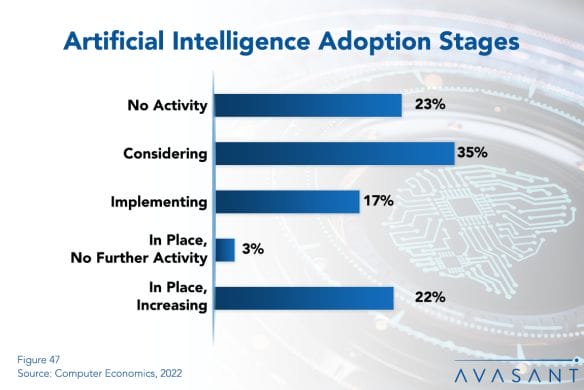After a relatively slow burn in recent years, more companies are now embracing artificial intelligence (AI) capabilities and projects, as shown in our annual Technology Trends survey. In the survey, AI showed impressive gains in both adoption and investment rates, compared to our survey in 2021. Infrastructure as a service (IaaS) also showed impressive gains in both adoption and investment rates among our survey respondents.
We appear to have reached an inflection point with AI, as many early, proof-of-concept projects have demonstrated success in reducing costs, increasing productivity, or improving the customer experience, which has prompted companies to increase their investments. This can be best demonstrated by the fact that a majority of companies that have already implemented AI are investing further in the technology.
Figure 47 from our full study, Technology Trends 2022, shows that 25% of companies in our survey have already implemented AI, as shown in the final two bars. Only 3% of companies in the survey have implemented AI and don’t plan further investments. AI adoption has jumped to 25% from 9% in 2021. When it comes to the investment rate, AI has a 39% investment rate, compared to 28% in 2021.
Artificial intelligence, as we define it, is not a single technology but several closely grouped technologies that allow for a machine to absorb and analyze data in order to make a recommendation or take an action. These technologies include rules-based reasoning, machine learning, speech recognition, natural language processing,

facial/object recognition, chatbots, and other artificial intelligence capabilities. These technologies are seldom deployed as a separate device or stand-alone system. They are usually embedded as features or capabilities within business applications.
“As use cases grow, AI seems to be passing the test in terms of sustaining value,” said Tom Dunlap, director of research for Computer Economics, a service of Avasant Research, based in Los Angeles. “Because the question with AI is not if it can be deployed, but how it can be deployed ethically and effectively to work alongside humans rather than replace them.”
There are several perceived advantages to AI that generally dictate the way it is used. Artificial intelligence can retain more information and evaluate more points of information than humans alone. It also can react more quickly to changes in information. As such, AI is especially good at automating routine processes that are subject to quickly changing environments, such as monitoring network activity for security incidents or reacting to real-time data from connected devices, such as IoT sensors.
The full study is designed to give business leaders insight into the staying power of 14 technologies that are currently top of mind for many companies. It provides a glimpse into how quickly an emerging technology is being adopted, how deeply more-established technologies are penetrating the market, and how positive the customer experience is with each technology. The study also delves into the specific types of solutions under consideration.
By understanding the adoption trends, investment activity, and customer experience, business leaders are in a better position to assess the potential risks and rewards of investing in each of these technology initiatives. They also can gain insight into just how aggressively competitors and peers are investing in these initiatives.
The full study also takes a quick look at an additional 19 early adopter and future technologies. These include blockchain, digital currencies, digital assistants, digital twins, drones, autonomous vehicles, quantum computing, 5G private networks, 6G networks, low-code/no-code, AI robotics, holograms, metaverse, non-fungible tokens, 3-D printing, human-computer interface, self-healing systems, Wi-Fi 6, and ultra-high-density storage. The study evaluates whether IT decision makers are familiar with these, whether they see a potential use for them, and whether they have already implemented them or have them installed.
Sample pages from the full study are available for free download.
This Research Byte is a brief overview of our study, Technology Trends 2022. The full report is available at no charge for subscribers, or it may be purchased by non-clients directly from our website (click for pricing).




